It’s no secret that sales prospecting is a crucial component of the sales process and plays a critical role in the success of any business.
By identifying and researching potential customers, businesses can better understand the needs and wants of their target market and tailor their sales efforts accordingly. This can lead to more effective B2B sales strategies and, ultimately, increased revenue.
- What Is Sales Prospecting?
- Why Is Sales Prospecting Important
- The Sales Prospecting Process
- Step 1: Do industry and market research
- Step 2: Get to know your ideal customer
- Step 3: Build a prospect list
- Step 4: Qualify your prospects
- Step 5: Decide on your prospecting channels
- Step 6: Start the conversation
- Step 7: Constantly monitor your performance and improve your results
- How to Do Sales Prospecting the Right Way
- Identify your ideal customer
- Use multiple channels
- Personalize your approach
- Follow up
- Track and measure results
- Sales Prospecting Tips
- 1. Show them who you are
- 2. Capitalize on referrals
- 3. Segment your prospects
- 4. Nurture your cold prospects with the 3×3 method
- 5. Create a database
- 6. Don’t be afraid to disqualify
- 7. Unveil and address objections
- 8. Check the prospects out on LinkedIn and email finders
- 9. Personalize your pitch
- 10. Offer helpful content
- What Is the Difference Between Leads and Prospects
- What’s the Difference Between Sales Prospecting and Lead Generation?
- When Does Prospecting Take Place in the Sales Process?
- Inbound vs Outbound Sales Prospecting
- What is Inbound Sales Prospecting
- What Is Outbound Sales Prospecting
- B2B vs. B2C Prospecting
- Sale Size
- Number of Decision-Makers Involved in the Process
- Prospecting Approach
- Technical Expertise
- Improve Your Sales Process
- How to Write a Sales Prospecting Email [+Templates]
- Sales Prospecting Templates
But what sales prospecting techniques will increase your success rate? What are the best prospecting tools for business? And how to increase sales with proper prospecting?
Read on for everything you want to know about sales prospecting, including tips, techniques, and templates. But first, let’s start with the basics!
What Is Sales Prospecting?
Sales prospecting is the process of identifying and researching potential customers for a business. It is an essential component of the sales process and involves actively seeking out and qualifying leads.
The prospecting process includes researching potential customers, identifying their needs and wants, and determining if they are a good fit for the company’s offerings.
Sales prospecting techniques come in various shapes, such as cold calling, emailing, networking, and social media. Sales representatives use these methods to find new qualified leads for your business and create a list of potential customers to reach out to.
Prospecting aims to identify potential customers who are most likely to make a purchase and qualify them as viable leads. Once a lead has been qualified, it is then passed on to the sales team for further engagement and ultimately closing a deal.
Why Is Sales Prospecting Important
Sales prospecting is vital for any business looking to grow and succeed in today’s competitive marketplace. The process of identifying and researching potential customers is essential for understanding the needs and wants of your target market and tailoring your sales efforts accordingly. This can lead to more effective B2B sales strategies and, ultimately, increased revenue.
One of the key benefits of sales prospecting is that it helps businesses to find new customers and expand their customer base. By identifying untapped markets and exploring new opportunities, businesses can stay ahead of their competitors and maintain a steady stream of new customers.
This is especially important for businesses that operate in highly competitive industries, where having a strong pipeline of leads is essential for success.
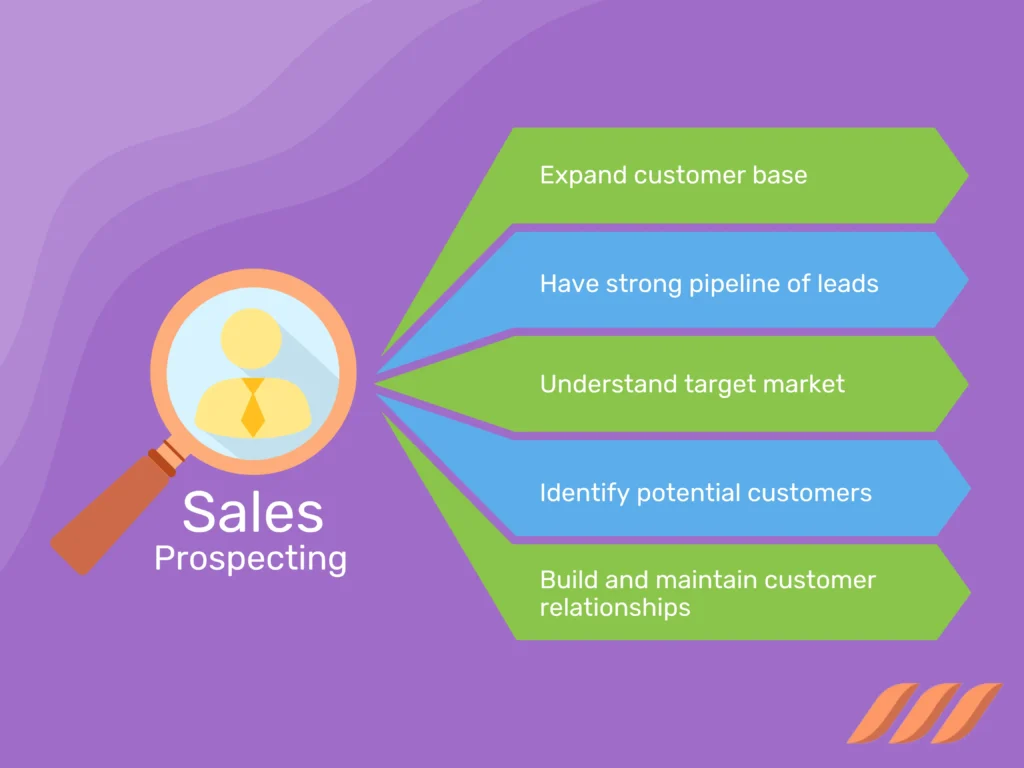
What’s more, sales prospecting helps businesses to understand their target market in a better way. Businesses can tailor their sales efforts by researching potential customers and identifying their needs and wants.
Additionally, by understanding your target market’s needs and wants, you can develop new products and services to meet those needs. Prospecting also enables businesses to identify potential customers who are most likely to make a purchase.
Using methods like cold calling, emailing, networking, and social media, sales representatives can find new leads and create a list of potential customers to reach out to. This helps increase the chances of closing a deal and ultimately generating revenue.
Moreover, prospecting helps in building and maintaining customer relationships. Reaching out to potential customers and engaging with them allows you to build trust and establish a relationship that can lead to repeat business and customer loyalty.
Further, businesses can personalize their approach and tailor their sales efforts to individual customer needs by keeping track of customer interactions.
The Sales Prospecting Process
There’s no one-size-fits-all approach to the sales prospecting techniques. However, most sales professionals and businesses follow the following 7 crucial steps.
Step 1: Do industry and market research
Before you begin prospecting, you must understand your industry and the market. This will help you identify potential customers and understand their needs.
Research should include digging into your customers’ needs and pain points and understanding your competitors’ strengths and weaknesses.
Plus, it is essential to identify and study any market trends that may impact your sales.
Step 2: Get to know your ideal customer
Once you understand your industry and market, the next step is identifying your ideal customer. This includes understanding their demographics, pain points, and what they want in a product or service.
Knowing your ideal customer will help you target the right prospects and create messaging that resonates with them.
Step 3: Build a prospect list
Once you know your ideal customer, it’s time to build a sales prospect list of potential prospects. This list should include the contact information of your prospects, such as their names, email addresses, and phone numbers.
You can use various methods to build your list, including social media scraping, LinkedIn profile scraping, networking, and purchasing lists from third-party companies.
Or maybe you’d want to capture contact information through a lead magnet.
Step 4: Qualify your prospects
After you have a list of potential prospects, it’s time to qualify them. Lead qualification means determining if the prospects are a good fit for your product or service and if they have the budget and authority to make a purchase.
This step will help you focus your efforts on the most promising prospects and save time by eliminating those that are unlikely to convert.
Step 5: Decide on your prospecting channels
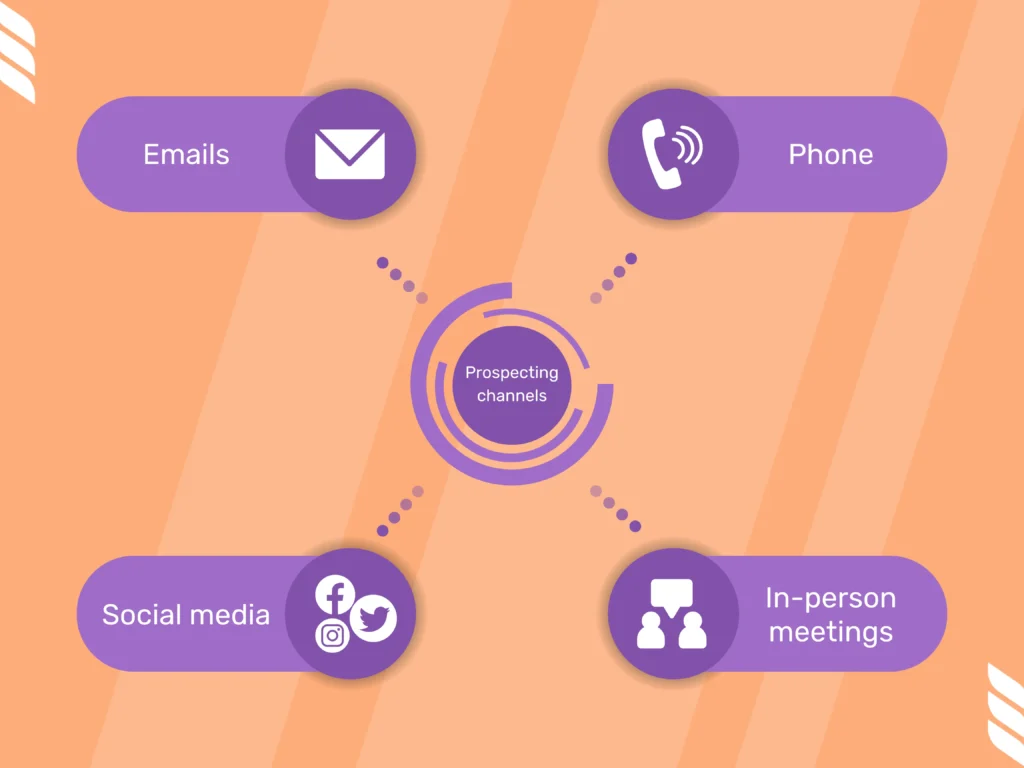
Next, it’s time to decide on your prospecting channels. This includes deciding how to reach out to prospects, such as by email, phone, social media, or in-person meetings. It’s important to choose the channels that will be most effective for reaching your specific target market.
Step 6: Start the conversation
With your prospecting channels in place, it’s time to start the conversation. In this step, you’ll finally contact your prospects and introduce yourself, your company, and your product or service.
This step aims to establish a relationship, nurture the prospect, and pass them on to the next step in the sales process, which is lead generation.
Step 7: Constantly monitor your performance and improve your results
The final step in sales prospecting is monitoring your performance and constantly improving your results. This includes tracking your progress, analyzing your results, and making necessary adjustments.
By monitoring your performance, you can improve your conversion rate, increase your return on investment, and ultimately achieve your sales goals.
With these seven steps, you can identify and qualify potential customers, create a pipeline of prospects, and ultimately achieve your sales goals.
How to Do Sales Prospecting the Right Way
Remember, not all sales prospecting techniques are created equal. Here’s how to do sales prospecting the right way.
Identify your ideal customer
Before you begin prospecting, it’s important to understand who your ideal customer is.
This will help you target your efforts and increase the likelihood of success.
Consider factors such as demographics, pain points, and buying habits when identifying your ideal customer.
Use multiple channels
Prospecting can be done through various channels, such as social media, email, phone calls, and networking events. Using multiple channels allows you to reach a wider audience and increases the chances of finding potential customers.
Personalize your approach
One of the most effective ways to prospect is to personalize your approach. This means tailoring your message to the specific needs and pain points of the individual or company you are reaching out to.
Personalization can also include using the recipient’s name, company name, and other details that you can gather about them in your communications.
Follow up
Following up with potential customers is crucial for closing a sale. According to a study by Brevet, 80% of sales require five follow-up calls after the initial contact. However, it’s important not to be pushy or salesy in your follow-up efforts. Instead, be patient, persistent, and professional.
Track and measure results
Tracking and measuring the results of your prospecting efforts is essential for understanding whether or not your B2B sales strategies are working. Using tools such as CRM software to keep track of your prospects and sales data is a good idea. This will help you identify patterns, adjust your strategy, and improve your results over time.
Sales Prospecting Tips
Here are 10 tips on how to do sales prospecting the right way:
1. Show them who you are
As a salesperson, your goal is to build trust with potential customers. One of the best ways to do this is by showing them who you are and what your company represents.
Sharing your company’s story, mission, and values with your prospects is a good idea. Plus, always be transparent and authentic. By doing so, you’ll be able to build a rapport with potential customers and increase the chances of closing a sale.
2. Capitalize on referrals
Referrals are one of the most powerful ways to prospect. They come from people who already trust you and your company, which makes them more likely to convert into customers.
Encourage your current customers to refer their connections to your business. Offer incentives, such as discounts or bonuses for successful referrals.
Read also: Where Does a Client Come From?
3. Segment your prospects

Not all prospects are created equal. This is where segmenting comes in handy!
Segmenting your prospects means grouping them based on factors such as demographics, pain points, and buying habits. Doing so will help you tailor your approach and increase your chances of success.
4. Nurture your cold prospects with the 3×3 method
Cold calling can be one of the most challenging aspects of sales prospecting. But the good news is that the 3×3 method can warm up potential customers before you make your pitch.
This method involves reaching out to a prospect three times before making a sales pitch.
- The first time, introduce yourself and your company;
- The second time, ask them questions or provide valuable information;
- The third time, make your pitch.
By warming up potential customers, you’ll increase their chances of being receptive to your message.
5. Create a database
Creating a database of potential customers during sales prospecting can help a business organize, and target leads for their products or services efficiently.
Your sales team can easily access and track information about potential customers, by having a database such as contact information, past interactions, and purchasing history. This can help the team prioritize leads and tailor their sales pitch to better match the needs and interests of each individual prospect.
Additionally, having a database can help a business identify patterns or trends among potential customers, which can help shape future sales and marketing strategies.
6. Don’t be afraid to disqualify
Not every prospect is a good fit for your business, so don’t hesitate to proceed with disqualifying prospects.
Disqualifying prospects means identifying those who are unlikely to convert into customers and moving on to other prospects. This will save you time and resources in the long run.
7. Unveil and address objections
Objections are a normal part of the sales process. Unmasking and tracking objections means understanding the underlying reasons why a potential customer is hesitant to buy. This will help you address their concerns and increase the chances of closing a sale.
8. Check the prospects out on LinkedIn and email finders
LinkedIn and email finders are powerful tools that can help you gather information about potential customers. You can use these tools to learn more about your prospects, such as their job title, company, and interests. This information will help you tailor your approach and increase your chances of success.
Related article: Top Prospecting Tips for Recruiters
9. Personalize your pitch
One of the most effective ways to prospect is to personalize your approach. You can do it by tailoring your message to the specific needs and pain points of the individual or company you are reaching out to. Personalization can also include using the recipient’s name, company name, and other details you can gather about them in your pitch.
10. Offer helpful content
Offering helpful content is a great way to build trust with potential customers. It is always good to look out for a chance to share valuable information, such as industry insights, tips, and best practices, with your prospects. By doing so, you’ll position yourself as a valuable resource and increase the chances of converting your prospects into leads or customers.
What Is the Difference Between Leads and Prospects
In the world of sales and marketing, the terms “leads” and “prospects” are often used interchangeably, but they actually refer to different stages in the sales process.
Let’s slice and dice lead vs. prospect.
A lead is a potential customer who has shown interest in your product or service. This can be through filling out a form on your website, signing up for a newsletter, or even just visiting your website. Leads are essentially people who have raised their hand and said, “I’m interested in what you have to offer.”
Prospects, on the other hand, are leads who have been qualified as having a higher likelihood of becoming customers.
Read also: How to Score and Grade Leads?
This qualification process involves identifying leads that are the best fit for your product or service, and determining their level of interest and readiness to buy.
In other words, leads are the people you have identified as potential customers, and prospects are the leads you have determined are most likely to make a purchase.
It’s important to note that not all leads will become prospects, and not all prospects will become customers. The goal of the qualification process is to identify the leads that are most likely to convert into paying customers so that you can focus your efforts on those individuals.
In summary, leads are potential customers who have shown interest in your product or service, while prospects are leads that have been qualified as being most likely to make a purchase. By focusing on prospects, you can increase your chances of closing a sale.
What’s the Difference Between Sales Prospecting and Lead Generation?

Sales prospecting and lead generation are two important activities in B2B marketing that businesses use to find and nurture potential customers. While these activities are closely related, they are not the same thing!
Sales prospecting is the process of identifying and qualifying potential customers for a business. It involves researching and finding individuals or organizations that are likely to be interested in the products or services that a business offers.
Sales prospecting typically focuses on finding new customers and is often done by sales representatives or business development teams. Lead generation, on the other hand, is the process of finding and nurturing potential customers who have shown interest in a business’s products or services.
This typically involves capturing contact information, such as an email address or phone number, from potential customers through forms, surveys, or other methods.
Lead generation is often done by marketing teams, and the leads generated are then passed on to sales teams for further qualification and follow-up.
In short, sales prospecting is about finding potential customers, while lead generation is about finding interested potential customers. In addition, sales prospecting is focused on finding new customers, while lead generation focuses on finding customers who have already shown some level of interest in a business’s products or services.
Both sales prospecting and lead generation are important for businesses, as they help identify and nurture potential customers. It is important to understand the differences between the two in order to effectively use them to generate new business.
When Does Prospecting Take Place in the Sales Process?
Prospecting is the first step in the sales process, and it is the process of identifying and qualifying potential customers for a business. It is an important step that helps salespeople determine which leads are worth pursuing and which ones are not. What’s more, knowing when prospecting takes place in the sales process will help you create a solid prospecting plan.
Prospecting can take place in a few different ways, depending on the industry and the type of product or service being sold. Some common methods include cold calling, networking, and using social media or other digital tools to reach out to potential customers.
One of the most important aspects of prospecting is identifying the target audience for the product or service. You can identify your prospects by researching the demographics, interests, and needs of the potential customers and then using that information to create a list to pursue.
Once the prospects have been identified, the next step is to qualify them. This involves determining whether or not they are a good fit for the product or service and if they are likely to make a purchase.
You can qualify prospects through various methods, such as asking questions, conducting surveys, or even visiting the potential customer’s business. Qualifying prospecting is essential because it helps you identify and qualify potential customers before investing too much time or resources into the sales process.
Inbound vs Outbound Sales Prospecting
There are two main methods of prospecting: inbound and outbound.
Both have their own advantages and disadvantages, and the best approach will depend on the specific needs of a business.
What is Inbound Sales Prospecting
Inbound sales prospecting involves attracting potential customers to the business through various marketing efforts, such as content marketing, search engine optimization, and social media. The goal here is to create valuable content that will attract the target audience and then use that content to generate leads.
Inbound prospecting is often considered a more passive approach, as it relies on the potential customer to initiate contact with the business. This new sales prospecting activity is becoming increasingly popular due to the rise of digital marketing and the growing importance of building trust and relationships with potential customers.
The inbound method tends to have a higher close rate than outbound prospecting.
Additionally, inbound prospecting is often more cost-effective than outbound prospecting, as it relies on digital marketing tools and channels.
What Is Outbound Sales Prospecting
Outbound sales prospecting is a more active approach, where salespeople reach out to potential customers through methods like cold calling, emailing, and direct mail. The goal of the outbound method is to generate leads by making direct contact with potential customers.
Outbound prospecting is often considered a more aggressive approach, as it requires salespeople to take the initiative to reach out to potential customers. While it may seem old school, outbound sales prospecting is still a very effective method of prospecting, particularly for businesses that sell products or services that are not well-known or that have a limited online presence.
This method allows salespeople to reach a wider audience and can be particularly effective for businesses that sell high-ticket items or services.
To summarize, inbound prospecting is a more passive approach that relies on attracting potential customers through digital marketing efforts and building trust and relationships with them. On the other hand, outbound prospecting is a more active approach where salespeople reach out to potential customers through cold calling, emailing, and direct mail.
Both methods have their own advantages and disadvantages, and the best approach will depend on the specific needs of a business.
B2B vs. B2C Prospecting
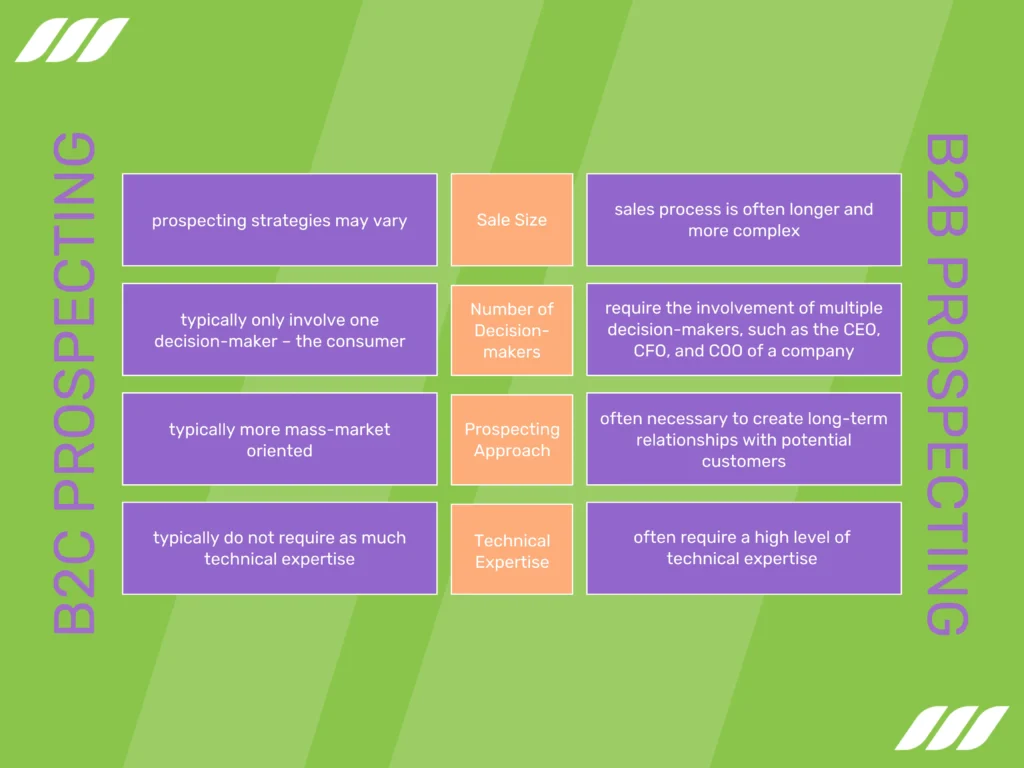
As explained above, prospecting is an essential part of any sales process, whether it is for a business-to-business (B2B) or business-to-consumer (B2C) product or service. The process of prospecting involves identifying and researching potential customers or clients and then approaching them with the goal of making a sale.
However, some key differences between B2B and B2C prospecting should be understood in order to be successful.
Sale Size
One of the biggest differences between B2B and B2C prospecting is the size of the sale. B2B sales are typically much larger than B2C sales, as they involve selling to businesses rather than individuals. This means that the sales process for B2B products or services is often longer and more complex than it is for B2C products or services.
Businesses have a greater need for a detailed and in-depth understanding of the product or service, and they often need to be convinced that the product or service will provide them with a significant return on investment.
And when it comes to B2C prospecting, the prospecting strategies may vary. For example, if a company is selling a high-priced item, such as a car or a house, it may need to invest more resources into finding and qualifying potential buyers. It may involve targeting specific demographics, such as individuals with high-income levels, and using more expensive forms of advertising, such as television or print ads.
In contrast, if a company is selling a lower-priced item, such as a book or a piece of clothing, it may be able to generate sales by targeting a wider range of individuals and using more cost-effective forms of advertising, such as social media or online search ads.
Additionally, companies selling low-priced items may be able to generate sales by using a “mass market” approach, where they reach out to a large number of individuals in hopes of converting a small percentage into customers.
Number of Decision-Makers Involved in the Process
B2B sales often require the involvement of multiple decision-makers, such as the CEO, CFO, and COO of a company. This means that the sales process for B2B products or services is often more complex and requires a greater degree of collaboration between sales teams and other departments within the company.
B2C sales, on the other hand, typically only involve one decision-maker – the consumer. However, it is important to remember that the number of decision-makers involved in B2C prospecting can vary depending on the product or service being sold and the type of customer being targeted.
For some products or services, such as a single book or a piece of clothing, a single individual may make a purchase decision. On the other hand, for more expensive or complex products or services, such as a car or a home, multiple decision-makers may be involved in the purchasing process.
This may include the primary decision-maker, who has the final say on the purchase, as well as other individuals, such as a spouse or family member, who may have input on the decision.
It’s important for B2C companies to consider the number of decision-makers involved in their prospecting efforts and tailor their marketing and sales strategies accordingly. This might involve targeting specific individuals or groups or using a multi-channel approach to reach different decision-makers at different stages of the buying process.
Prospecting Approach
In B2B prospecting, it is often necessary to create long-term relationships with potential customers, as these relationships can lead to repeat business and referral business.
It may require a more targeted and personalized approach to lead generation, such as developing a more targeted sales prospecting campaign and attending industry events. But B2C lead generation is typically more mass-market oriented, such as online advertising and social media campaigns.
Technical Expertise
B2B sales often require a high level of technical expertise, as the products or services being sold are often complex and require a deep understanding of the industry. B2C sales, on the other hand, typically do not require as much technical expertise, as the products or services being sold are often consumer goods or services.
Improve Your Sales Process
Improving your sales process is a key step in growing your business and increasing revenue.
By streamlining and optimizing your sales process, you can increase efficiency, close more deals, and ultimately drive more revenue for your company.
Here are a few ways to improve your sales process:
- Define your target market: Understanding your ideal customer is crucial for effective sales. By defining your target market, you can tailor your sales pitch, marketing efforts, and overall strategy to better reach and engage with potential customers;
- Qualify leads: Not all leads are created equal. By qualifying leads, you can prioritize the ones that are most likely to convert into customers. This will help you to focus your efforts on the leads that are most likely to close, rather than wasting time and resources on those that are unlikely to buy from you;
- Create a sales pipeline: A sales pipeline is a visual representation of the sales process. It helps to identify where leads are in the buying process and what steps need to be taken to move them to the next stage. You can better manage your sales process and track progress by creating a sales pipeline;
- Use technology: Technology can help automate and streamline many aspects of the sales process, from lead generation to tracking progress. By using the best sales prospecting tools such as the Dripify sales automation software, you can better manage your leads, create drip campaigns, track progress, and measure performance;
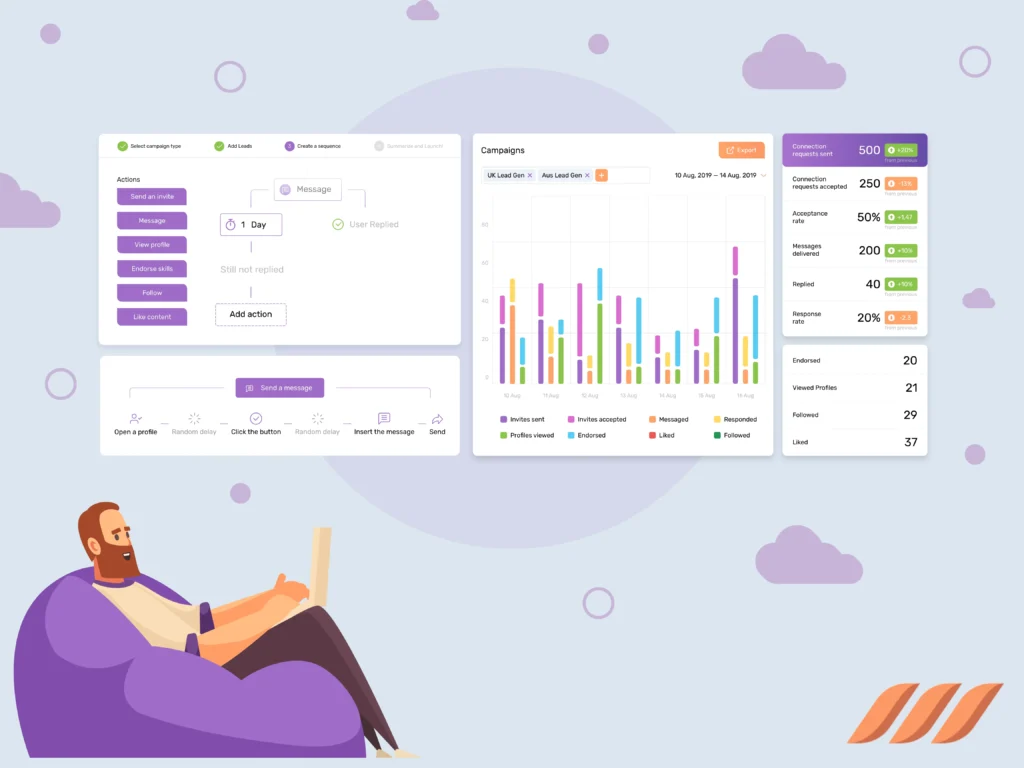
- Continuously improve: The sales process is constantly evolving, so it’s important to continuously monitor and improve it. By analyzing data and feedback, you can identify areas of improvement and make changes to your process;
- Use the best sales automation tools: Automation and sales prospecting go hand in hand. Thankfully, many of the best sales automation tools like Dripify allow you to put many prospecting activities on autopilot.
Read also: Why You Need Dripify for Sales Teams
By following these steps, you can improve your sales process and drive more revenue for your business. Remember, the key is to continuously monitor and improve your process to stay ahead of the competition and meet your customers’ needs.
How to Write a Sales Prospecting Email [+Templates]
Email prospecting is a powerful solution for reaching out to potential customers and generating leads. However, writing an effective prospecting email can be tricky.
You want to grab the recipient’s attention, convey your message clearly, and leave a strong impression.
Here are a few tips for writing a successful sales prospecting email:
- Personalize the email: Good email personalization strategy is key when it comes to email prospecting. By addressing the recipient by name, referencing their specific needs or interests, and tailoring your message to their specific situation, you are more likely to grab their attention and make a connection;
- Keep it short and sweet: People are bombarded with emails every day, so it’s important to keep your sales prospecting email concise and to the point. Get to the point quickly and clearly, and avoid using jargon or industry-specific language that the recipient may not understand;
- Use a clear subject line: Your subject line is the first thing the recipient will see, so it’s important to make it clear, compelling, and to the point. Use action-oriented language and avoid using words that may trigger spam filters. Learn more about how to avoid email spam filters;
- Provide value: Instead of just trying to sell something, provide value to the recipient. Offer them something of value, such as a helpful resource, a discount, or a complimentary consultation;
- Include a call-to-action: Your email should include a clear call-to-action, such as scheduling a meeting or requesting more information. Make it easy for the recipient to take the next step.
Sales Prospecting Templates
Here’re a few template you can use as a starting point for your sales prospecting email:
Template 1
Subject: [Your company name] – [Your product/service]
Dear [Recipient’s name],
I hope this email finds you well. I came across your company [Company name] and noticed that you might be in need of [Your product/service]. I wanted to reach out and offer my assistance.
[Your product/service] has helped many companies like yours to [specific benefit/achievement]. I would like to schedule a call with you to discuss how it can benefit your company as well.
Please let me know if this is something that interests you, and a good time for us to schedule a call.
Thank you for your time,
[Your name]
Template 2
Subject: Introducing [Your Company Name] – Solutions for [Industry]
Dear [Recipient’s Name],
I hope this email finds you well.
My name is [Your Name] and I am reaching out from [Your Company Name], a leading provider of [products/services] for [industry]. I noticed that your company [Company Name] is also in the [industry], and I wanted to introduce our solutions to you.
We have helped many companies like yours to [achieve specific results/goals]. I would love to schedule a call or an appointment with you to discuss how we can help your company achieve similar results.
Please let me know if this is something that interests you, and a good time for us to have a call or in-person meeting.
Thank you for your time,
[Your Name]
Template 3
Subject: Introduction from [Referral Name] – [Your Company Name]
Dear [Recipient’s Name],
I hope this email finds you well. My name is [Your Name] and I am reaching out from [Your Company Name], a leading provider of [products/services].
I was recently referred to you by [Referral Name], who highly recommended that I reach out to you regarding our [products/services].
We have helped many companies like yours to [achieve specific results/goals]. I would love to schedule a call with you to discuss how we can help your company achieve similar results.
Please let me know if this is something that interests you, and a good time for us to schedule a call.
Thank you for your time,
[Your Name]
Template 4
Subject: Follow-Up – [Your Company Name]
Dear [Recipient’s Name],
I hope this email finds you well. My name is [Your Name] and I am reaching out from [Your Company Name], a leading provider of [products/services].
We recently met at [event/location], and I wanted to follow up with you regarding our [products/services].
We have helped many companies like yours to [achieve specific results/goals]. I would love to schedule a call with you to discuss how we can help your company achieve similar results.
Please let me know if this is something that interests you, and a good time for us to schedule a call.
Thank you for your time,
[Your Name]
Template 5
Subject: Invitation to our upcoming webinar – [Webinar Topic]
Dear [Recipient’s Name],
I hope this email finds you well. My name is [Your Name] and I am reaching out from [Your Company Name], a leading provider of [products/services].
I wanted to invite you to our upcoming webinar, [Webinar Topic], where we will be discussing [specific topic/problem] and how our [products/services] can help solve it.
The webinar will be held on [date] at [time], and will include [what attendees can expect from the webinar]. Please register for the webinar by [date], and we will send you the link to join.
I look forward to having you join us and discuss how we can help your company achieve similar results.
Thank you for your time,
[Your Name]
Begin Sales Prospecting
Sales prospecting is a crucial aspect of any successful sales strategy. It allows businesses to identify and pursue potential customers, which can lead to increased revenue and growth.
By regularly prospecting and using the best sales prospecting tools, companies can maintain a steady pipeline of leads and continuously expand their customer base.
Additionally, the right prospecting techniques can help businesses stay ahead of the competition by identifying new market opportunities and trends.
Overall, investing time and resources into effective sales prospecting can have a significant impact on a company’s bottom line.
Now that you know everything you wanted to learn about prospecting, it’s time to supercharge your business growth with the sales prospecting techniques, tips, and templates provided in this article.
Happy Prospecting!

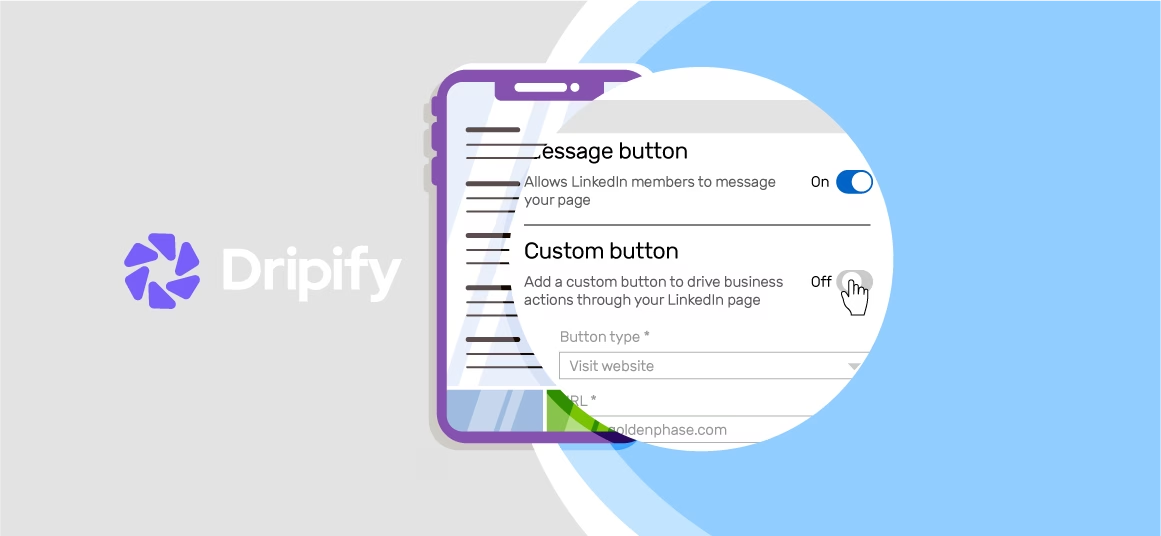
![Email Outreach Tracking [Tips, Tricks and Tools]](https://dripify.io/wp-content/uploads/2025/02/11-7-png.avif)
![Create a Prospecting Plan [+8 Prospecting Methods]](https://dripify.io/wp-content/uploads/2025/02/11-png.avif)